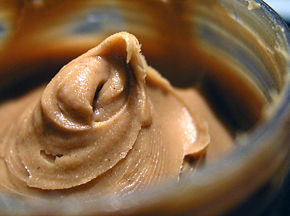
Food rheology
Encyclopedia

Rheology
Rheology is the study of the flow of matter, primarily in the liquid state, but also as 'soft solids' or solids under conditions in which they respond with plastic flow rather than deforming elastically in response to an applied force....
properties of food, that is, the consistency and flow of food under tightly specified conditions. The consistency, degree of fluidity, and other mechanical properties are important in understanding how long food can be stored, how stable it will remain, and in determining food texture. The acceptability of food products to the consumer is often determined by food texture, such as how spreadable and creamy a food product is. Food rheology is important in quality control
Quality control
Quality control, or QC for short, is a process by which entities review the quality of all factors involved in production. This approach places an emphasis on three aspects:...
during food manufacture and processing. Food rheology terms have been noted since ancient times. In ancient Egypt
Egypt
Egypt , officially the Arab Republic of Egypt, Arabic: , is a country mainly in North Africa, with the Sinai Peninsula forming a land bridge in Southwest Asia. Egypt is thus a transcontinental country, and a major power in Africa, the Mediterranean Basin, the Middle East and the Muslim world...
bakers judged the consistency of dough by rolling it in their hands.

Solid
Solid is one of the three classical states of matter . It is characterized by structural rigidity and resistance to changes of shape or volume. Unlike a liquid, a solid object does not flow to take on the shape of its container, nor does it expand to fill the entire volume available to it like a...
, gel
Gel
A gel is a solid, jelly-like material that can have properties ranging from soft and weak to hard and tough. Gels are defined as a substantially dilute cross-linked system, which exhibits no flow when in the steady-state...
, liquid
Liquid
Liquid is one of the three classical states of matter . Like a gas, a liquid is able to flow and take the shape of a container. Some liquids resist compression, while others can be compressed. Unlike a gas, a liquid does not disperse to fill every space of a container, and maintains a fairly...
, emulsion
Emulsion
An emulsion is a mixture of two or more liquids that are normally immiscible . Emulsions are part of a more general class of two-phase systems of matter called colloids. Although the terms colloid and emulsion are sometimes used interchangeably, emulsion is used when both the dispersed and the...
with associated rheological behaviors, and its rheological properties can be measured. These properties will affect the design of food processing
Food processing
Food processing is the set of methods and techniques used to transform raw ingredients into food or to transform food into other forms for consumption by humans or animals either in the home or by the food processing industry...
plants, as well as shelf life
Shelf life
Shelf life is the length of time that food, drink, medicine, chemicals, and many other perishable items are given before they are considered unsuitable for sale, use, or consumption...
and other important factors, including sensory properties that appeal to consumers. Because foods are structurally complex, often a mixture of fluid and solids with varying properties within a single mass, the study of food rheology is more complicated than study in fields such as the rheology of polymers. However, food rheology is something we experience everyday with our perception of food texture (see below) and basic concepts of food rheology well apply to polymers physics, oil flow etc. For this reason, examples of food rheology are didactically useful to explain the dynamics of other materials we are less familiar with. Ketchup is commonly used an example of Bingham fluid and its flow behavior can be compared to that of a polymer melt .
Psychorheology
Psychorheology is the sensory judgement of rheological properties. It is a term used in the food industry, to describe how a food "feels" to the mouth. It is not necessarily straightforward to predict how a food will "feel" based purely on the true rheological properties.The most important factor in food rheology is consumer
Consumer
Consumer is a broad label for any individuals or households that use goods generated within the economy. The concept of a consumer occurs in different contexts, so that the usage and significance of the term may vary.-Economics and marketing:...
perception of the product. This perception is affected by how the food looks on the plate as well as how it feels in the mouth, or "mouthfeel
Mouthfeel
Mouthfeel is a product's physical and chemical interaction in the mouth, an aspect of food rheology. It is a concept used in many areas related to the testing and evaluating of foodstuffs, such as wine-tasting and rheology. It is evaluated from initial perception on the palate, to first bite,...
". Mouthfeel is influenced by how food moves or flows once it is in a person's mouth and determines how desirable the food is seen to be.
See also
- CosmeticsCosmeticsCosmetics are substances used to enhance the appearance or odor of the human body. Cosmetics include skin-care creams, lotions, powders, perfumes, lipsticks, fingernail and toe nail polish, eye and facial makeup, towelettes, permanent waves, colored contact lenses, hair colors, hair sprays and...
- Pharmaceuticals
- Food ScienceFood scienceFood science is a study concerned with all technical aspects of foods, beginning with harvesting or slaughtering, and ending with its cooking and consumption, an ideology commonly referred to as "from field to fork"...
- Food TechnologyFood technologyFood technology, is a branch of food science which deals with the actual production processes to make foods.-Early history of food technology:...
- Aseptic ProcessingAseptic processingAseptic processing is the process by which a sterile product is packaged in a sterile container in a way that maintains sterility...
- Dietary supplementDietary supplementA dietary supplement, also known as food supplement or nutritional supplement, is a preparation intended to supplement the diet and provide nutrients, such as vitamins, minerals, fiber, fatty acids, or amino acids, that may be missing or may not be consumed in sufficient quantities in a person's diet...
- Food fortificationFood fortificationFood fortification or enrichment is the process of adding micronutrients to food. It can be purely a commercial choice to provide extra nutrients in a food, or sometimes it is a public health policy which aims to reduce numbers of people with dietary deficiencies in a population.Diets that lack...
- Food preservationFood preservationFood preservation is the process of treating and handling food to stop or slow down spoilage and thus allow for longer storage....
- Food storageFood storageFood storage is both a traditional domestic skill and is important industrially. Food is stored by almost every human society and by many animals...
- Food supplements
- NutraceuticalNutraceuticalNutraceutical, a portmanteau of the words “nutrition” and “pharmaceutical”, is a food or food product that reportedly provides health and medical benefits, including the prevention and treatment of disease. Health Canada defines the term as "a product isolated or purified from foods that is...
- Nutrification (aka food enrichment or fortification)
- Food and Bioprocess TechnologyFood and Bioprocess TechnologyFood and Bioprocess Technology: An International Journal is a peer reviewed scientific journal published by Springer Science+Business Media. It is available in print and online...
- Food safetyFood safetyFood safety is a scientific discipline describing handling, preparation, and storage of food in ways that prevent foodborne illness. This includes a number of routines that should be followed to avoid potentially severe health hazards....
- Food microbiologyFood microbiologyFood microbiology is the study of the microorganisms that inhabit, create, or contaminate food. Of major importance is the study of microorganisms causing food spoilage. "Good" bacteria, however, such as probiotics, are becoming increasingly important in food science...
- Food chemistryFood chemistryFood chemistry is the study of chemical processes and interactions of all biological and non-biological components of foods. The biological substances include such items as meat, poultry, lettuce, beer, and milk as examples...
- Food packagingFood packagingFood packaging is packaging for food. It requires protection, tampering resistance, and special physical, chemical, or biological needs. It also shows the product that is labeled to show any nutrition information on the food being consumed....
- Food EngineeringFood engineeringFood engineering is a multidisciplinary field of applied physical sciences which combines science, microbiology, and engineering education for food and related industries. Food engineering includes, but is not limited to, the application of agricultural engineering, mechanical engineering and...

